(About Me) (My Profession) (News & Media) (Prayer Time)
(Visit Kelantan)
(MIDI Collections) (Basic HTML) (Local Fruits) (Recipies) (Home)


|
| City clock tower |
Kelantan, meaning "Land of Lightning", occupies the north-east part of the country. It shares borders with Perak , Terengganu, Pahang and Thailand. The State is renowned for traditional handicrafts such as gold and silver jewellery, and traditional pastimes such as top-spinning, puppet plays and kite-flying. The State capital is Kota Bharu.
Traces of hunting and gathering activities in rock shelters dating back to what archaeologists refer to as the ´Hoabinhian´ period have been discovered at Gua Cha and Gua Musang in inland Kelantan. These caves were occupied by Hoabinhians between about 10,000 and 3,000 B.C. The Hoabinhian are named after cave sites in northern Vietnam. In later times, Kelantan came under the sway of the first great power in Southeast Asian history - the Empire of Funan. Farming methods used in Kelantan today are believed to have their origins in Funan, as do the ever-popular Wayang Kulit shadow play and local weaving techniques. Kelantan was at this time variously referred to as "Ho - Lo - Tan", "Chih - Tu" and "Tan - Tan".
By the mid-7th Century a new maritime power, Srivijaya, had emerged, and Kelantan soon became a vassal of this Sumatran empire. Upon the demise of this power, it paid homage to the Siamese, an arrangement that was to last until the emergence of the new Malacca Sultanate in the 15th Century. With the demise of this sultanate, Kelantan was ruled first by ohore in the 17th Century, and later by Terengganu in the 18th Century.
By the early 1800s, Kelantan was easily one of the most populous and prosperous States in Malaya. This was due to largely to the fact that, like its neighbour Terengganu, Kelantan was ´ignored´ by the concerted efforts that were being made to develop the resources found on the west coast. Thus ignored, Kelantan went on with her own largely unimpeded development. Kelantan did, however, maintain strong ties with Siam throughout the 19th Century.
Kelantan lost her ´independence´ with control of the state passing to British hands following the signing of the Anglo-Siamese Treaty Of 1909. When Japan first landed her troops upon Malayan soil in Kelantan during World War II and the Occupation followed, control of the state was passed to Thailand. Kelantan became a member of the Federation of Malaya in 1948.
The State of Kelantan is located towards the north-eastern part of Peninsula Malaysia. It is bordered by Terengganu to the east and south-east, Pahang to the south and Perak to the west. To the north it shares an international border with Thailand. Kelantan has a fairly short coastline of approximately 60 kilometres, which fronts onto the South China Sea. The State occupies a land area of 14,943 square kilometres, and its´ capital Kota Bharu, with a population of approximately 400,000, lies to the extreme north of the State. Other towns of note in Kelantan include Tumpat, Pasir Mas, Rantau Panjang, Bachok, Pasir Puteh, Tanah Merah Machang, Kuala Krai and Gua Musang. Agricultural activities take up most of the flat land of the State, with paddy-growing being the main activity in this sector. The State is quite hilly in places, and two fairly large rivers, Sungei Kelantan and Sungei Golok, drain the waters from the hills to the sea. Rainfall during the months of November to December can be quite high, owing to the North-east Monsoon which blows during this period. Temperatures range between 25 degrees Celcius and 32 degrees Celcius, with humidity averaging 90%.
As the Malays form about 93% of the population, the Malay language is the most common language heard in Kelantan. In addition to this, some dialects of Chinese are spoken, along with a smattering of Thai, especially in Tumpat. Very occasionally, an Indian language may be heard.
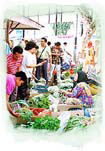
|
| Central market at Kota Bharu |
Agriculture forms the backbone of the Kelantan economy. In 1993, 22% of the State´s GDP came from this sector. Total land area under agricultural cultivation is around 25% of the total land area in the State, with rubber and paddy taking up about 65% of this total. Paddy was cultivated on 80,000 hectares, and production was estimated at 286,000 metric tonnes in 1993. Rubber took up 156,000 hectares, of which 57% was cultivated by smallholders with the rest being cultivated in big estates. Tobacco is beginning to make up a bigger portion of the State´s GDP, and is becoming an ever more important cash crop. The State produces more than 90% of Malaysia´s total production of this crop.
Other important economic sectors in Kelantan include mining. Kelantan has viable deposits of manganese, gold, copper, barite, lead and zinc, in addition to deposits of granite, sand and limestone. Cottage industries such as the manufacture of keropok (prawn crackers), dried fish, and budu, a fish paste, are continually being promoted by the State Government. In addition to this, Kelantan is also encouraging the development of its´ handicrafts industry.
With some of the best reserves of timber in the country, Kelantan has good potential in this sector for the future. A star in the making is the manufacturing sector which, in 1993, contributed 12% of the State´s GDP. Tourism, on the other hand, is one area of the State´s economy which has not been exploited to anywhere near its´ full potential. Besides the natural beauty it has to offer visitors, Kelantan truly has a rich cultural tradition which can be utilised in the promotion of tourism.
Kelantan has a population of about 1.4 million, of which approximately 95% are Malays, with the minorities comprising Chinese, Indians, Thais and Orang Asli or indigenous people. Being predominantly Islamic, the population tends to follow a conservative lifestyle, and this blends well with Kelantan´s rustic setting of paddy fields, picturesque kampungs and unspoilt beaches.
Islam is the State Religion, with small numbers of people practising faiths such as Buddhism, Hinduism and Christianity.
The ancient arts which once thrived throughout the country during breaks in the planting and harvesting seasons, and during the monsoon breaks, have all but disappeared from the west coast states. But in the east coast in general, and in Kelantan in particular, popularity in these art forms is as strong as ever.
DANCE
The Mak Yong, a Malay dance drama which was performed exclusively for sultans and territorial chiefs until the turn of the century, combines dance, opera, drama and comedy. When royal patronage ceased, Mak Yong left the confines of the palace and became popular among the rural folk. The main cast of Mak Yong is made up of women, consisting of four leading actresses who play the king, a young prince, the queen (Mak Yong) and a princess. Male actors are included for comic relief. Mak Yong performers are accompanied by musicians who play the violin-like rebab, the gendang (a double-headed drum) and the tetawak (a gong). A male shaman or bomoh, follows a Mak Yong troupe to ensure the success of its performances.
Other Kelantanese court dances include the Tarian Payang, named after fishing boats and traditionally danced on the beach while waiting for fishermen to return, and the Tarian Asyik. The Tarian Garong is an up-tempo dance performed by five couples in a circle, whilst the Tarian Piring, a graceful dance symbolizing the offering of gifts to God on a small plate, the piring, is another popular dance.
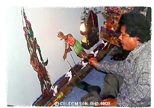 |
| Wayang Kulit show |
The Wayang Kulit, or shadow puppet drama, is said to have originated from Java in the 14th Century, although the shadow play in Kelantan is particularly eclectic, combining not only Javanese, but also Chinese, Indian and Siamese influences. The repertoire includes enacting tales from the great Indian epics the Ramayana and the Mahabharata, together with tales on local folklore.
Behind a small raised stage supporting a large white screen sits the Tok Dalang, or master puppeteer. Sticking the buffalo-hide-and-stick puppets into banana stems positioned behind the screen, he then narrates the tale as he ´manipulates´ the puppets. A lamp, suspended between the screen and the puppeteer, causes the silhouettes of these puppets to dance on the screen. The narration is complemented by a small traditional orchestra consisting mainly of percussion instruments.
MUSIC
A popular musical pastime is the beating of the harvest drum, the rebana besar. This drum measures 60 centimetres in height and one metre in diameter. The drum is placed on its side and is struck with the palm of the hand. In common with the other northern States, popular traditional musical forms include the religious songs and chants known as "Berzanji" and "Qasidah". The "Hadrah" which is an Islamic chant, is performed with dances and musical accompaniment. Singing and reparteeing in doggerel form is popular in Kelantan. This musical form is known as "Dikir Barat".
DRESS
This is one of the few States in Malaysia, in which will be seen traditional forms of dressing everyday. Ladies wear the traditional Baju Kurung which consists of a loose fitting blouse and a Sarung or the Baju Kebaya, which consists of a tight fitting blouse and a Sarung. They also cover their heads in the Islamic tradition with tudungs. Older ladies may wear head scarves instead, and are well-known for wearing gold bangles as these used to represent, at least in the past, their only measure of wealth besides the land and the animals they owned. The men tend to wear the traditional Baju (loose shirt top) with Seluar (long pants) and a Sarung wrapped around their midriff. All three of these garments are made of a fine, light coloured material, suitable for the prevailing weather. In Kelantan particularly, men are more likely to wear Serban (turbans) to cover their heads rather than Songkoks (Malay headwear similar to the fez of Middle Eastern origins, but smaller and black in colour). These Serbans are plain coloured and are not ostentatious. Some Malays (and Muslims from other races) may wear a white Topi (cloth cap) on their head. Usually, these are worn by Muslims who have made the pilgrimage to Holy Mecca. A more elaborate form of head dress worn by the Malays is the Tanjak or Tengkolok. These are worn during ceremonial or Royal Occasions.
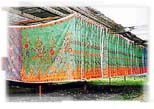
|
| Batik Kelantan |
Kelantan is truly a great Malay cultural centre, which keeps the skills and traditions of a bygone age in an age of increasing commercialism and modern appliances usage. The people of the State produce a wide variety of art, craft and handicraft items, which are not only pleasing to the eye, but are also functional and environmentally friendly.
Amongst the woven handicrafts are those which use the mengkuang leaf and bamboo strips as a base. The products resulting from these raw materials are mats, bags, hats and conical food covers. Then there woven handicrafts relying on cloth. Amongst these cloths are batik, silk and Kain Songket. All three of these produce fine examples of craftsmanship and design. Using their skills in woodworking, the Kelantanese produce detailed woodcarvings and extend to traditional methods of boat-building, evident especially near the town of Tumpat.
They also produce intricate designs on silverware, for which the State is justly famous. Kelantan is one of the very few States in Malaysia which still retains the skills of its´ silversmiths. Finally, to serve and preserve the pursuits of traditional games and pastimes in the State, there are excellent craftsmen in Kelantan producing beautiful kites and tops both for individual pleasure and for competitive purposes.
Kite-flying is hugely popular here, not only among the boys but also the men. The most popular kite, or "wau"., is the moon kite, so named because of its crescent-shaped tail. Competitions are regularly held, and the winners are judged not only on how the kite flies, but also on the shape, colour and ornamentation, as well as on the grace with which the kite can be manoeuvred.
Top-spinning in Kelantan is basically an adult affair. Contests are held between pairs of men to determine how long one´s top, or "gasing", can spin. After the initial throw of the spin, it is expertly transferred to a stand, where it is left spinning until it stops.
Finally, there is the traditional pastime of rearing birds for their singing prowess, and then entering them in bird singing contests. This pastime is popular in the northern States as a whole. The bird normally used for this purpose in Kelantan is the merbok. Bull-fighting, which used to be a very popular pastime in Kelantan during the past, is now banned.
Besides the usual religious festivals celebrated in the country as a whole, Kelantan is internationally renowned for hosting the International Kite Festival at Pantai Sri Tujuh near Tumpat. This is an annual event which attracts participants from all over the world.
In addition to the National Public Holidays enjoyed by Malaysians, the Kelantanese enjoy the Muslim Holidays of Nuzul-Al-Quran and an Additional Holiday for Hari Raya Qurban. They also celebrate the Birthday of His Royal Highness, the Sultan of Kelantan.
Kota Bharu
Our tour of the State begins at Kota Bharu, the northernmost city on the East Coast and the capital of Kelantan. A bustling city, Kota Bharu sprawls along the eastern bank of the fertile Kelantan River and is the hub of the rice basin. It serves as the seat of the royal sultanate and is a convenient gateway to Thailand. The nearby border crossing between Rantau Panjang and Sungai Golok is a popular destination for those who wish to buy goods from across the border.

|
| Central Market |
In the center of town, along Jalan Tengku Chik is the Pasar Besar (Central Market), the hub of the town and site of arguably the most colourful market in Malaysia. Witness the entrepreneurial skills and diligence of the Kelantanese women, as the majority of the business here is conducted by them. Dressed in batik, with their heads veiled, these women haggle over prices whilst chewing on betel nut. They sell a whole range of items, from fresh fruits and vegetables to cakes and sweetmeats; from spices and preserved food to batik and handicrafts. The vibrant market is housed in a modern octagonal building and is a delight to the senses, as the clash of colours and sounds compete with irresistible aromas for your attention. Savour the entire spectacle bathed in the yellow light which streams through a translucent roof. Opposite the Central Market is a vacant lot which at night plays host to numerous food-stall operators. Partake of some of Kelantan´s finest cuisine as you dine under the stars!
Just beyond the market is Padang Merdeka (Independence Square), a memorial that was established following World War II, and also the site where the body of the respected nationalist, Tok Janggut, was exhibited by the British, who killed him at Pasir Puteh in 1915 after he led a rebellion against them. A visitor to Padang Merdeka will be impressed by the cluster of museums close by.
Situated between Jalan Hilir Kota and Jalan Hulu Kota and surrounded by high wooden walls, is the Istana Balai Besar (Palace of the Large Audience Hall). Built in 1844, this palace boasts of elaborately-carved gates and is still used for ceremonial and legislative purposes.
A superb example of Kelantanese craftmanship is evident in the
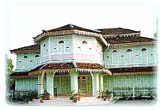
|
| Jahar Palace Kota Bahru |
Turn left from Istana Jahar and you will come to a blue-and-white building, the Istana Batu (Brick Palace). This palace houses the Muzium di-Raja (Royal Museum), which has on display, among other items, replicas of the crown jewels.
Across the road from the World War II Memorial Museum is the Muzium Islam (Islamic Museum). A Pattani-style tiled roof crowns this beautiful old wooden building which displays information tracing the history of Islam in the state and whose exhibits include photographs of the personal belongings of the Prophet Muhammad.
The War Museum (Bank Kerapu) lies closes to the river and has the distinction of being housed in the oldest brick building in the State. Built in 1912, it was formerly occupied by a bank. This museum contains basically a collection of memorabilia relating to the Japanese occupation of Malaya during World War II.
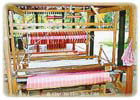
|
| A Batik factory |
Finally, across the road from Istana Batu is the Kampung Kraftangan (Handicraft Village), an imposing building fashioned in traditional Kelantanese style. The state´s renowned crafts are on display and exhibitions are held on subjects such as ceramics., batik-painting and silk-weaving. Information on programmes are available from the Tourist Information Centre on Jalan Sultan Ibrahim.
The Gelanggang Seni (Cultural Centre) situated along Jalan Sultan Mahmud, showcases the State´s cultural heritage. Listen to the sounds of the rebana (drums) coming from small huts as colourful "wau" or kites float above you in the sky. On the green, "gasing" or top-spinning experts hold court. Other performances include the Wayang Kulit ( a shadow puppet play ), the Mak Yong (a Malay dance drama) and the Silat (Malay form of self-defense).
Next to the Tourist Information Centre on Jalan Sultan Ibrahim is the State Museum. Exhibited are a wide array of artifacts, crafts, traditional instruments, paintings and photographic displays all connected in some way or another with the state of Kelantan.
Kota Bharu is surrounded by a patchwork of little ´kampungs´. Located within the fertile Kelantan Basin, these villages lie between rice fields and fruit orchards and are linked to each other by little roads. About 10 kilometres south of Kota Bharu is Kampung Nilam Puri, home to Masjid Kampung Laut, reputed to be Malaysia´s oldest mosque. The mosque, built about 300 years ago by Javanese Muslims in grateful thanks after a narrow escape from pirates, used to be located on the banks of the Kelantan River but considerable damage to the wooden building brought on by the annual monsoon floods caused it to be removed here in 1968.
Tumpat & District
About 15 kilometres north of Kota Bharu is Tumpat, a major agricultural area bordering Thailand and which is the final stop on the east coast railway line. The Thai influence here is very noticeable as this border town is home to Kelantan´s Thai Buddhist minority and there are several Thai Buddhist Temples or "Wats" in the area. At Wat Photivihan, a 40 metre-long reclining Buddha is claimed to be one of the largest in Southeast Asia.
Time-warped Tumpat has hardly gone through changes in decades. The old wooden railway station is still very much the town´s central point of focus and many original shophouses still line the same road. Tumpat is long renowned for producing skilled boat-builders, and the beaches of Tumpat provide the visitor with an opportunity to see these master craftsmen fashion elaborately carved shapes of mythical birds or demons onto the bows of their boats.
North of Tumpat is Pantai Sri Tujuh, a popular beach and boating lagoon, and venue of the International Kite Festival. Watch as fishermen cast a huge net offshore and then haul it in by hand.
A few kilometres from Pantai Sri Tujuh, right on the Thai border, is Pengkalan Kubur. An immigration check-point for Thai-bound travellers, Pengkalan Kubur has car-ferry services which cross the river to Tak Bai in Thailand. The other border town, Rantau Panjang, southwest of Kota Bharu, is popular with bargain hunters. On the Thai side is Golok.
Kuala Krai & District
About 70 kilometres south of Kota Bharu lies Kuala Krai. There is a small zoo here specialising in local wildlife. A river trip from here will take you to Dabong, two hours´ journey to the southwest. The trip will take you through dense jungle. A short walk from Dabong leads to caves and waterfalls. Dabong is on the jungle railway line.
Gua Musang & District
Gua Musang (Musang Cave) lying on the edge of the massive Taman Negara about 185 kilometres south of Kota Bharu, owes its name to the caves in the limestone outcrop towering above the railway station. Although rarely seen here nowadays, the musang, a native civet cat with long fur and a long curling tail, used to inhabit these caves.
This small town makes a good centre for exploring caves, trekking or making a riverboat safari. Trekkers can climb the 898 metres tall Gunung Ayam, once home to the legendary Kelantanese Queen.